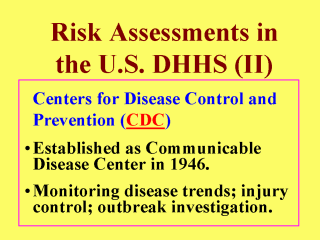| front |1 |2 |3 |4 |5 |6 |7 |8 |9 |10 |11 |12 |13 |14 |15 |16 |17 |18 |19 |20 |21 |22 |23 |24 |25 |review |
 |
Another unit of
the U.S. Department of Health and Human Services (DHHS) is the Centers for Disease Control
and Prevention (CDC), whose mission is to prevent and control unnecessary disease,
disability, and death primarily by monitoring disease trends and investigating outbreaks.
Its involvement in health risk assessment (RA) is largely through its three centers, one
program, and one institute. These include the National Center for Environmental Health,
the National Center for Infectious Disease, the National Center for Injury Prevention and
Control, the National Immunization Program, and the National Institute for Occupational
Safety and Health (NIOSH). The RA methods used in CDC vary greatly, ranging from the reliance on largely qualitative information to the use of site-specific data. Identification of disease-related hazard typically takes place through surveillance programs, laboratory research, epidemiologic studies or investigations, and prevalence surveys. NIOSH places a great emphasis on epidemiologic and exposure data derived from all available sources including its own surveillance programs. Well recognized case studies from CDC on RA include: the toxic shock syndrome reported in 1980; the swine flu inoculation program launched in 1976; the DTP (diphtheria, tetanus, pertussis) immunization program since the late 1940s; the occupational exposure to the grain and produce fumigant ethylene dibromide, which is carcinogenic; and the issuance of a criteria document on occupational exposure to styrene (U.S. DHHS, 1986). |